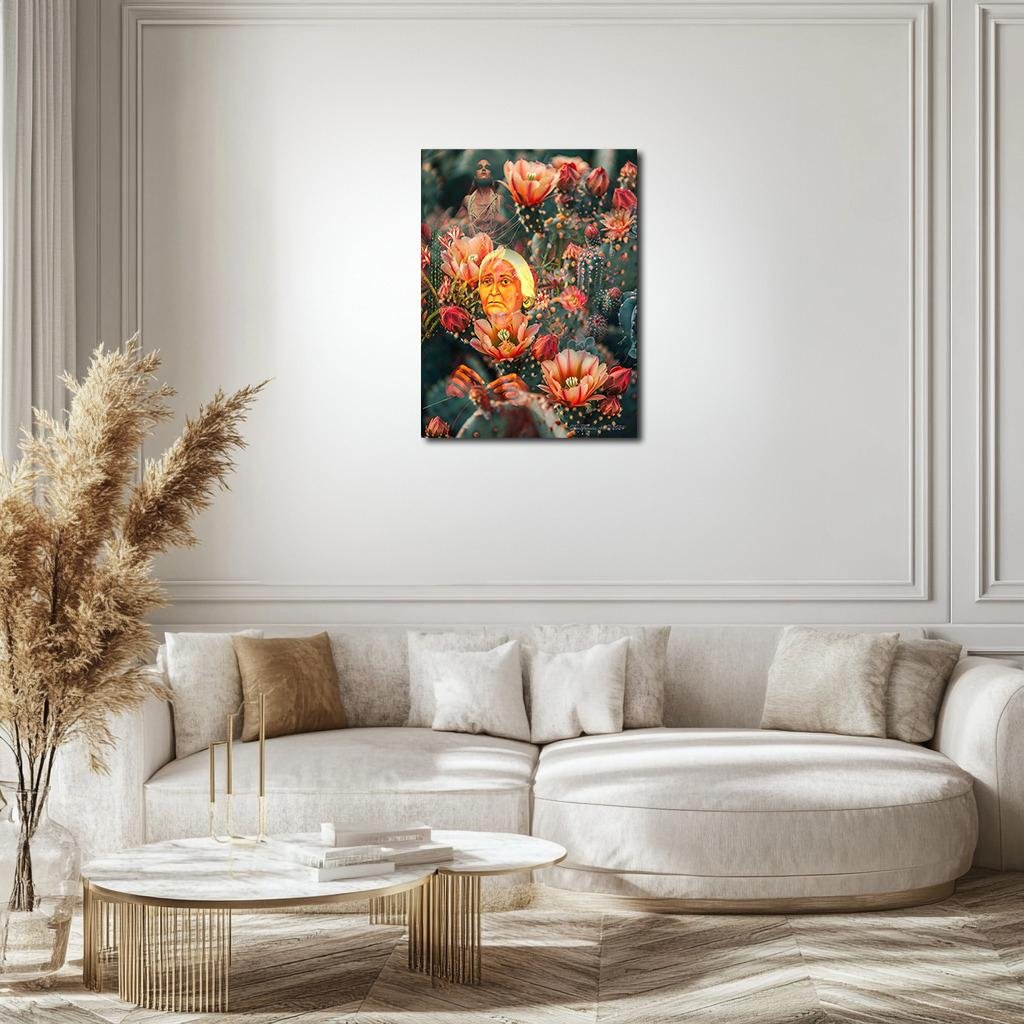The Thorns That Bloom: Frida’s Devotion to Rosita Morillo
The Thorns That Bloom reimagines Frida Kahlo’s Portrait of Doña Rosita Morillo as a sacred floral landscape, where cactus blooms and thorned silence honor matriarchal strength. Through golden ochres, coral petals, forest greens, and ghostly whites, Rosita emerges not as muse, but as memory’s gardener—tending invisible threads of labor, lineage, and love. In this surreal desert of softness and survival, Kahlo’s tribute becomes a meditation on the quiet beauty that endures beneath every thorn.
Please see Below for Details…
Hotline Order:
Mon - Fri: 07AM - 06PM
404-872-4663
This conceptual reimagining of Frida Kahlo’s Portrait of Doña Rosita Morillo merges ancestral dignity with the raw resilience of earth-born beauty, creating a living tribute to matriarchal strength rooted in silence, memory, and bloom. Titled The Thorns That Bloom , the work transforms Doña Rosita’s enduring presence into a floral constellation, where cactus spines and desert blossoms swirl together in a mythic landscape of age, heritage, and tenderness. Kahlo’s portrait becomes not merely a representation of a woman, but a reverent invocation of the feminine as sustainer—quietly weaving survival through each needle and bloom.
At the core of the piece is Rosita’s face—calm, aged, and illuminated by the golden warmth of late-life fire. Her gaze is direct yet gentle, the look of a woman who has watched the seasons turn, who has lost many things, and still reaches forward. Her white hair glows like a halo against the shadowed greens of cactus flesh, not sacred in a religious sense, but divine in its honesty and presence. Her expression holds the gravity of earth wisdom—no embellishment, no performative softness—only the quiet, necessary endurance passed through generations of women.
Around her blooms a surreal cactus garden, not rendered in static realism but in vibrant, breathing abstraction. Pale pinks, deep corals, and sunset oranges burst from thick green paddles, each flower opening like a whispered story, each spine trembling like a warning. Rosita’s hands are suspended mid-thread, the delicate motion of stitching or weaving captured like an eternal gesture—an echo of every grandmother’s labor, invisible yet foundational.
The color narrative of The Thorns That Bloom flows with layered emotional resonance. The base is steeped in deep, lush forest greens and muted teals, representing the rich, arid life of the desert—hard yet sustaining. These greens form the quiet breath beneath Rosita’s image, holding her in a space of cultivated silence, a life of roots grown deep under heat and time. The cactus pads shimmer slightly with a powdery light, almost silvered, suggesting that survival—even in stillness—gathers its own shine.
Rising from this foundation are the flowers: painted in radiant pinks, soft tangerines, and rich coral hues, each petal layered with lifeblood and sunlight. These tones are warm, feminine, fierce. They speak of beauty that does not apologize for the scars that made it. The blooms surround Rosita’s face like bursts of emotion—gratitude, loss, labor, and sacred solitude, all unfolding slowly, insistently.
Threaded through the composition are gentle accents of dusty lavender and rose ash, tones that speak of memory and faded grief. These are the colors of old linens, dried petals, and letters never sent. They settle around Rosita’s shoulders like a memory shawl, adding to the sense that she carries more than just her own life—she carries the quiet weight of many.
In the upper portion, the sky dissolves into dreamlike mist, awash with milky whites and soft bone-colored swirls. From this clouded ether, ghostly figures emerge—abstract forms of youth, of vulnerability, of the unfulfilled. These translucent presences contrast Rosita’s dense presence below, suggesting that life is not only shaped by what is lived, but by what remains forever imagined or unfinished.
When I created The Thorns That Bloom , I wanted to honor Doña Rosita not as an icon or an ideal, but as a vessel of sacred dailiness—the kind of woman whose labor is unrecorded, whose pain is private, and whose strength is embedded in every task. Frida Kahlo’s original portrait of Rosita was reverent and plainspoken, a testimony to emotional realism. In this reinterpretation, I wanted her to dissolve into the very landscape she belongs to, her presence inseparable from the natural forces around her: blooming under pressure, soft in spite of thorns, enduring in silence.
The composition spirals outward like a flowering cactus—Rosita at the core, the blossoms radiating, and the edges marked by the strange, sacred figures of absence. There is no hierarchy here, no grand scene or sweeping gesture—only rhythm, breath, and bloom. It is an ecosystem of quiet strength, a hymn to women who do not demand history’s gaze but hold it up regardless.
Add your review
Your email address will not be published. Required fields are marked *
Please login to write review!
Looks like there are no reviews yet.








